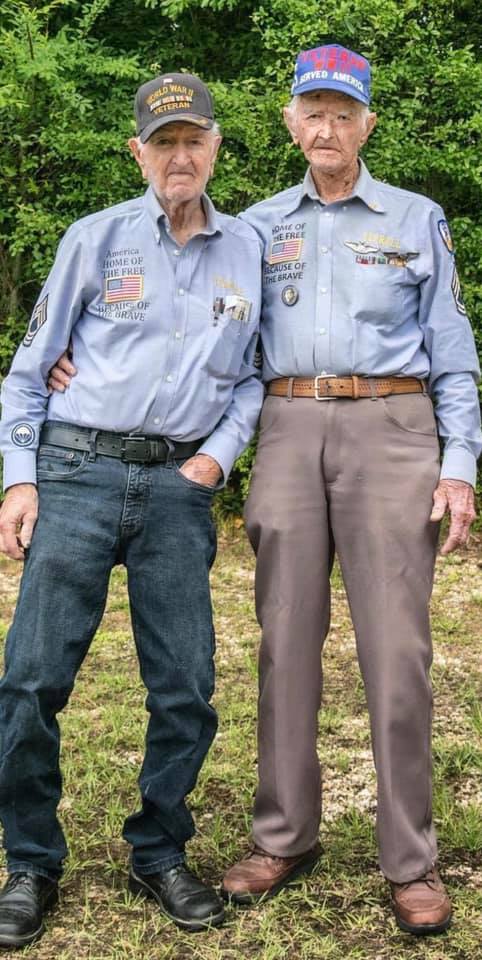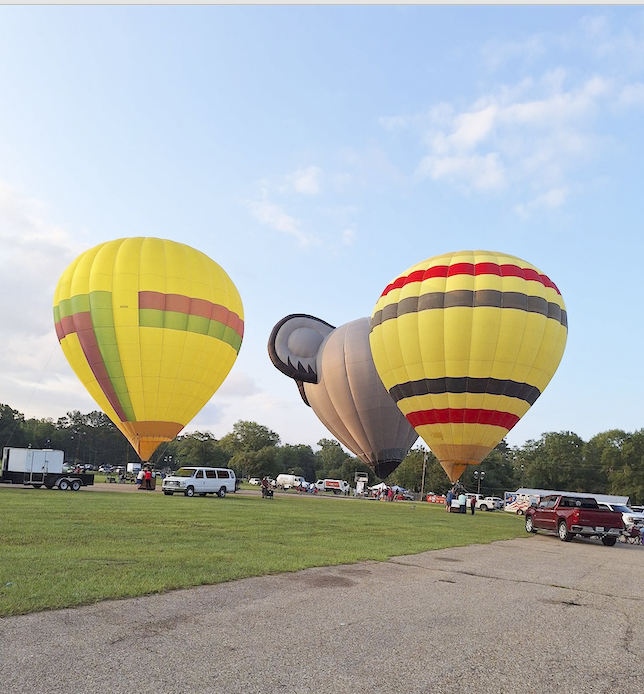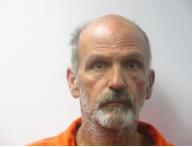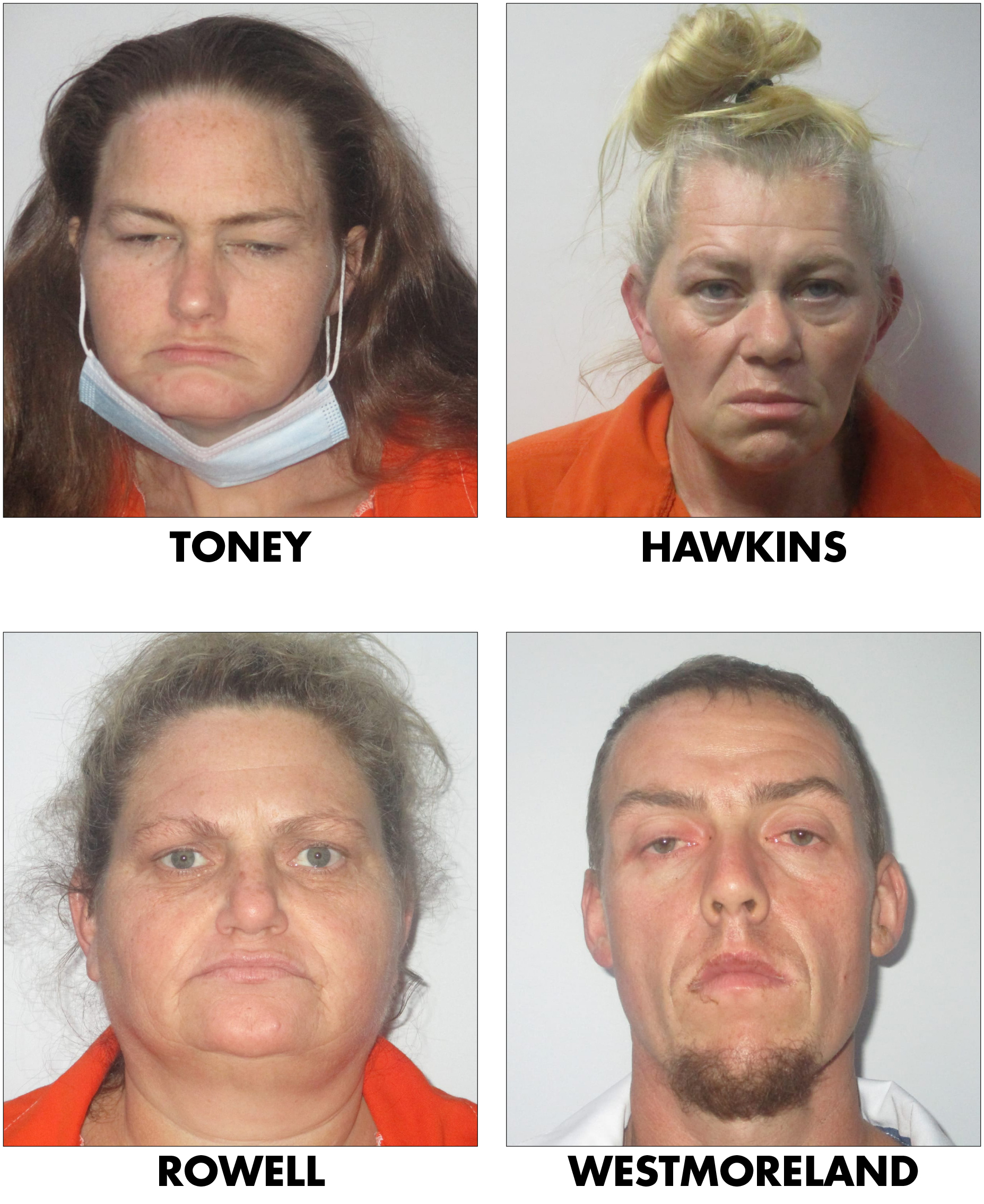Three brothers recalled 1944 D-Day invasion
Published 4:02 pm Monday, May 26, 2025

- This photo from June 2021 shows brothers Ubert Terrell, 100, right, and L.C. Terrell, 98, who were both invading Normandy on D-Day, one on the ground and the other by air.
|
Getting your Trinity Audio player ready...
|
Editor’s note: This story was written a number of years ago, but the history of these three local men and others should be remembered as American, British and Canadian military joined forces on D-Day to end World War II.
By BOB ANN BRELAND
It was June 6, 1944.
Three brothers prepared for battle — each in his own separate way, neither knowing where the other was or what they were doing.
One was in the U.S. Air Force, one in the U.S. Army and one in the U.S. Navy.
Ubert Terrell was an Air Force crew chief aboard a C47 transport plane dropping paratroopers, equipment and supplies over Normandy.
L.C. Terrell, after extensive special forces training with the Army, hit the beach at Normandy.
Johnny Terrell was on the other side of the world at Pearl Harbor that day, aboard a Navy troop carrier, the USS John Land, loading his ship with approximately 2500 troops to invade Saipan on June 15, some nine days later.
Another brother, Dalcus Terrell, who was above the draft age for world War II, was making his contribution by working in a shipyard in Slidell, making it possible for them to carry on in Europe and the Pacific.
Meanwhile at home, their mother cared for their two sisters, Lola and Ester Lee, while furnishing the war effort with three of her four sons, each of whom would serve over two years in continuous combat conditions. Like many mothers with sons in this terrible war, she prayed for them daily, and by the grace of God, they all survived.
The parents of the men, Martin Terrell and Ollie Ball, had married Oct. 3, 1908. Their father died Dec. 30, 1928, leaving their mother a widow with six children to raise. The boys came up strong, hardened by necessity.
“During the war, Mother was home alone again,” Johnny Terrell remarked.
TSgt. Ubert Terrell, now 79 and the oldest of the brothers, began his Normandy invasion work at 12:30 a.m. on June 6, dropping paratroopers into the area.
“I took in a paratrooper from Bogalusa that night, but I forgot his name,” Ubert said.
He returned to the same area at 10 a.m. with a double glider tow, bringing in infantry and equipment. The gliders were towed to the area by the planes, then released and glided to a landing on the ground. It turned out to be a very bad idea, as most of the glider pilots and the men were killed by the Germans on the ground before they landed or shortly thereafter.
Ubert’s brother L.C. was on the ground when the gliders came in. He saw what happened.
“They had a hard time. There wasn’t a survivor in them when they landed,” L.C. commented sadly.
“We went from England to Italy, supplied troops from Rome to the Arno River and from Italy we dropped troops into southern France,” Ubert said. It is significant here to mention that Ubert served in constant combat from then on for almost three years, in France, Holland, Belgium and across the Rhine in the Battle of the Budge, in his capacity as a crew chief and also in intelligence — from the Normandy invasion until the war was over. He did a lot of evacuation of the wounded and American prisoners of war, resupplied missions behind the lines and took on casualties of war.
He was presented a total of 17 medals for battles and campaigns, including the Air Medal with Oak Leaf Cluster — which he was given 11 times!
“Anything that happened after Normandy, I was in it,” Ubert said.
While he was in the air at Normandy, L.C. Terrell, now 76, was landing on the beaches with the invasion forces.
“The Marines had a tough time when they hit the beach,” L.C. said.
Indeed they did. On June 6, 1944, some 9,758 Americans were killed, wounded or reported missing in the Normandy invasion.
L.C. was in the Army a little over five years When he went in, he was assigned to reconnaissance in Gen. George Patton’s second division. After attending school, he was sent to Fort Meade, MD., where he was given specialty training in beach landings, and was assigned to replacement in a unit in England.
“I went into a veteran outfit,” L.C. said, adding that he took 56 men with him to bring the unit back up to full strength. They trained on FCPB’s — the “Higgins” craft which had been built at Higgins Shipyard in New Orleans. The really intense training on the beach prepared them for the invasion.
“The Army had us honed into really fine instruments,” he commented, adding that mentally and physically, they were ready for the invasion. “Few people knew where they were going,” he said, “But we did. We knew the terrain, the area and what was about to happen. The French had given us intelligence as to where the German guns were located. We knew what — we just didn’t know when — but we were ready.”
L.C. was part of the initial assault on Utah Beach. It was a big joint operation. The Navy was firing broadside, softening up the area. His group was participating in the beach landing with a mission to search and destroy. It was “close-up” fighting.
“The Germans were good fighters and they were hunkered down. The sea assault and the air assault didn’t quite take care of it — the ground troops had to do it. When Ubert dropped fighters in, they were to cut off communications, but our mission was different. We all had to contend with wire, land mines, other mines and booby traps. They all took their toll. We lost a lot of men.”
They took the Cherbourg Peninsula, which was needed for a port to bring in troops and they also took Omaha Beach. They lost one in three men or better, L.C. commented. Over 2000 men were lost at Omaha Beach alone.
“Gen. Patten came in to St. Lo and met the major part of the battle. Our cousin, the late Richard Jenkins, served with Patten and received a Silver Star for his action. The commanding officers took different views on awarding citations. Mine believed if you were alive at the end of the day and you had done what you were supposed to do, that was citation enough,” L.C. said.
“I credit my good training and a praying mother for being here today,” he added. “I hurt myself many times, but I never took a bullet.”
“My mother-in-law always said I ‘was just in the Navy,’” Johnny Terrell, now at 73 the youngest of the brothers, said laughing, as he began his story.
His war adventures happened during the same time frame as his brothers, just in a different part of the world.
He had trained in San Diego — supposedly for 12 weeks, but the training was cut short after only five weeks because the men were really needed for the war in the Pacific. After only 11 weeks in the Navy, he was taking part in the invasion of Saipan. Aboard the troop supply ship USS John Land, during 11 invasions in the Pacific and a terrible typhoon, nobody on the ship was killed or nobody even got sick and died. But it was far from uneventful.
“Every invasion was D-Day,” he commented. His ship picked up the president of the Philippines and his staff in New Guinea, and the ship carrying Gen. Douglas MacArthur met them and took the Philippine president from their ship before MacArthur’s famous return to the Philippines.
Johnny was in the Navy two years, one month and 18 days, and he served in the Pacific in the heaviest action during two of those years. Johnny’s adventures were detailed in a separate story in The Daily News a few years back.
Ubert came home from the war and became a heavy equipment operator. He and his wife, Nanetta Adams Terrell, live in Sun. They have two sons, Aubrey, who is field supervisor for the border patrol in El Paso, TX, and Bruce, who is chief of quality control and chief of construction for the Corps of Engineers in New Orleans. They also have grandchildren and great-grandchildren. Another son is deceased.
L.C. settled into a career in law enforcement and retired as Bogalusa’s Assistant Chief of Police. Later he was into off-shore drilling. He married Ellen Bankston, who is now deceased, and they have four daughters: Joy, who is a medical doctor, Kathryn, a human resource specialist in Thomasville, GA; Janice, who is a Registered Nurse in Lafayette, and Gaynell, a journalism graduate of LSU, who lives and works in Little Rock, AR.
“When I got out of service, I said if I can live through this, I won’t do anything for a year. I didn’t, but it was a mistake. I had a hard time getting a job,” he said, laughing. Johnny tried several things including sales, then worked for Standard Coffee, then went into steel fabricating , welding and fitting. A certified pipe welder, he is proud that he also became a coded welder. He and his wife Betty McKenzie Terrell, live in Bogalusa. They have two sons, John David, who is employed by Gaylord, and Robert Bryan, a post office supervisor. They are equally proud of their grandchildren and the fact that as the result of Johnny’s 20 years as an associate Explorer advisor, his two sons helped the local Explorers win a national championship.
Ubert was quick to give other service personnel credit for the victory at Normandy and others during World War II.
“The guy on the tail end of the supply line and the one on the front were as much a part of the whole effort as those who did it,” Ubert affirmed.
“The three of us share a unique position. We are all friends, also brothers and comrade in arms. All our lives it’s been one for all, and all for one,” L.C. said. “When we four brothers get together, we have a good time. We get along well.”
These three country boys were far, far from home as they fought and were involved in tragic and heartbreaking action, seeing many men die for freedom.
They believe their mother’s prayers and good training brought them home for long and happy lives.





